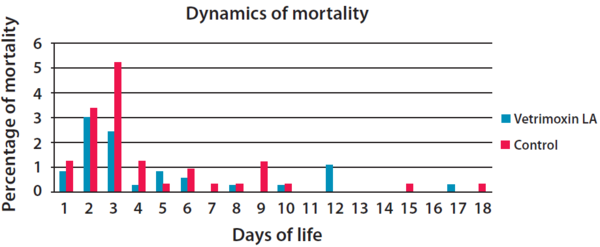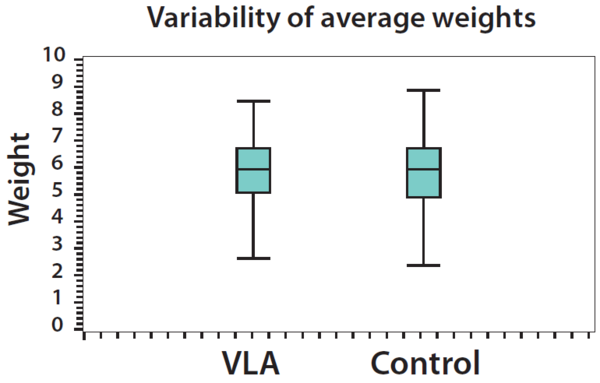.
-->Introduction
-->Results
-->Conclusions
.
CLINICAL EFFICIENCY OF VETRIMOXIN® LA IN THE CONTROL OF EARLY MORTALITY IN SUCKLING PIGLETS
By Krejci R.1, Malasek J.2, Lopez A.1
1Ceva, Libourne, France;
2Veterinary consultant, Zdar n Sazavou, Czech Rep.
.
Introduction
Suckling piglets are exposed to infections within first hours of life. The first contaminations with Streptococcus suis (S.suis) can occur already during parturition, when piglets come in contact with the vaginal secretions of sows, shedding the bacteria (Amass 1996).
The clinical signs of S. suis infection develop mostly at the age of 10-21 days, but in some occasions even earlier, particularly in males due to previous castration. Prophylactic use of efficient antibiotics can reduce the incidence of the disease and decrease the losses due to mortality or crushing of weak, sick piglets.
The aim of this study was to evaluate the efficacy of prophylactic treatment with Vetrimoxin® LA (amoxicillin inj., Ceva) in the farm with endemic S. suis infections in suckling piglets.
.
Materials and methods
Sows were randomly assigned into two treatment groups according to their parity. Piglets of the group 1 (G1) were treated within the first 24 hours after parturition with 0.5 ml Vetrimoxin® LA (VLA). Non-treated piglets of the second group (G2) served as the control. In total 372 piglets were included in the G1 and 327 piglets in the G2. Cross fostering was performed exclusively within each of the treatment groups.
All piglets were weighed at 1 day and 18 days of life. The third day of age all piglets obtained 1 dose of 200mg iron dextran and one dose of 20mg/kg of toltrazuril as the prevention of anemia and coccidiosis. The mortality was recorded daily per pen.
^ Top page
.
Results
1.Daily percentage of mortality
The majority of deaths occurred within first 3 days of life.
Vetrimoxin® LA treated piglets had lower mortality particularly on day 3 and 4 of age (Figure 1).
Figure 1 Daily percentage of mortality
In total the mortality in the Vetrimoxin® LA treated group reached 9.68% while the mortality in the control group was 14.98% (Figure 2). There was statistically significant difference in favour of the Vetrimoxin® LA group (Chi² test p=0.0322).
Figure 2 Cumulative mortality between days 1-18 of age.
^ Top page
.
2. Growth performance
In spite of mild differences between both groups in the initial and final average weights, there was no difference in the calculated average daily gain. The weight variation was lower in the Vetrimoxin® LA group, however the difference was not statistically significant (Figure 3).
Figure 3 Box-plot representation of weights on day 18 of age
^ Top page
.
Conclusions
Vetrimoxin® LA administered to suckling piglets 24 hours after birth decreased significantly the mortality in the pre-weaning period from almost 15% to 9.7%. The cumulative mortality includes the sudden deaths, crushing and deaths after the acute disease.
Early prophylactic treatment decreased the mortality due to the infection itself and in addition to that, healthy and more vital piglets might have had better chance to evade crushing. The average weight gain was not improved in the treated group, which indicates that the growth rate was not severely affected by those infections which were controlled by amoxicillin.
^ Top page
.
Bibliography
Amass S.F. et al., 1996; Swine Health and Production, 269-272
.
(Source: Axis Issue 02 / Sept 2013 - Ceva Asia Pacific - Proceedings APVS 2013)
.
Related topics: axis swine technical information mortality vetrimoxin la piglet efficacy

 Corporate Website
Corporate Website
 Africa
Africa
 Argentina
Argentina
 Asia
Asia
 Australia
Australia
 Belgium
Belgium
 Brazil
Brazil
 Bulgaria
Bulgaria
 Canada (EN)
Canada (EN)
 Chile
Chile
 China
China
 Colombia
Colombia
 Denmark
Denmark
 Egypt
Egypt
 France
France
 Germany
Germany
 Greece
Greece
 Hungary
Hungary
 Indonesia
Indonesia
 Italia
Italia
 India
India
 Japan
Japan
 Korea
Korea
 Malaysia
Malaysia
 Mexico
Mexico
 Middle East
Middle East
 Netherlands
Netherlands
 Peru
Peru
 Philippines
Philippines
 Poland
Poland
 Portugal
Portugal
 Romania
Romania
 Russia
Russia
 South Africa
South Africa
 Spain
Spain
 Sweden
Sweden
 Thailand
Thailand
 Tunisia
Tunisia
 Turkey
Turkey
 Ukraine
Ukraine
 United Kingdom
United Kingdom
 USA
USA
 Vietnam
Vietnam






